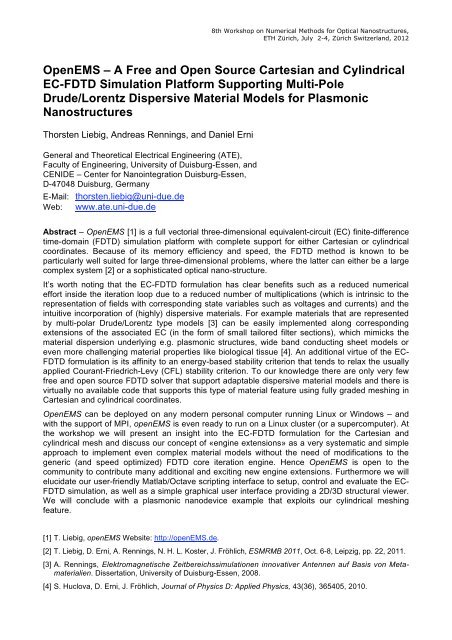

- #Open source fdtd portable
- #Open source fdtd software
For new users, the most important items to review are the Introduction, Tutorial/Basics, and FAQ.

Documentationįor a list of topics, see the left navigation sidebar.

Installation instructions are in Installation. Gzipped tarballs of tagged versions are in Releases. The source repository is hosted on GitHub. Tutorial/Basics provides examples of the various kinds of computations. Meep's scriptable interface makes it possible to combine many sorts of computations along with multi-parameter optimization in sequence or in parallel. Green's functions) - in response to an arbitrary source via a continuous-wave (CW) input (fixed-ω).
Resonant Modes and Frequencies - by analyzing the response of the system to a short pulse, one can extract the frequencies, decay rates, and field patterns of the harmonic modes of lossy and lossless systems including waveguide and cavity modes. Transmittance and Reflectance Spectra - by Fourier-transforming the response to a short pulse, a single simulation can yield the scattering amplitudes over a broadband spectrum. This can be used to calculate a wide variety of useful quantities. Visualization routines for the simulation domain involving geometries, fields, boundary layers, sources, and monitors.Ī time-domain electromagnetic simulation simply evolves Maxwell's equations over time within some finite computational volume, essentially performing a kind of numerical experiment. Adjoint solver for inverse design and topology optimization. Field analyses including discrete-time Fourier transform (DTFT), Poynting flux, mode decomposition (for S-parameters), energy density, near to far transformation, frequency extraction, local density of states (LDOS), modal volume, scattering cross section, Maxwell stress tensor, absorbed power density, arbitrary functions completely programmable. GDSII file import for planar geometries. ε/μ and field import/export in the HDF5 data format. Frequency-domain solver for finding the response to a continuous-wave (CW) source as well as a frequency-domain eigensolver for finding resonant modes. Custom current sources with arbitrary time and spatial profile as well as a mode launcher for waveguides and planewaves, and Gaussian beams. Subpixel smoothing for improving accuracy and shape optimization. Exploitation of symmetries to reduce the computation size, including even/odd mirror planes and 90°/180° rotations. Perfectly matched layer ( PML) absorbing boundaries as well as Bloch-periodic and perfect-conductor boundary conditions. Materials library containing predefined broadband, complex refractive indices. Variety of arbitrary material types: anisotropic electric permittivity ε and magnetic permeability μ, along with dispersive ε(ω) and μ(ω) including loss/gain, nonlinear (Kerr & Pockels) dielectric and magnetic materials, electric/magnetic conductivities σ, saturable gain/absorption, and gyrotropic media (magneto-optical effects). Precompiled binary packages of official releases via Conda. #Open source fdtd portable
Portable to any Unix-like operating system such as Linux, macOS, and FreeBSD.  Distributed memory parallelism on any system supporting MPI. Simulation in 1d, 2d, 3d, and cylindrical coordinates. Complete scriptability via Python, Scheme, or C++ APIs.
Distributed memory parallelism on any system supporting MPI. Simulation in 1d, 2d, 3d, and cylindrical coordinates. Complete scriptability via Python, Scheme, or C++ APIs. #Open source fdtd software
Free and open-source software under the GNU GPL. Meep is a free and open-source software package for electromagnetics simulation via the finite-difference time-domain ( FDTD) method spanning a broad range of applications. Tutorial/Multilevel Atomic Susceptibility. Tutorial/Resonant Modes and Transmission in a Waveguide Cavity. Synchronizing the Magnetic and Electric Fields.








 0 kommentar(er)
0 kommentar(er)
